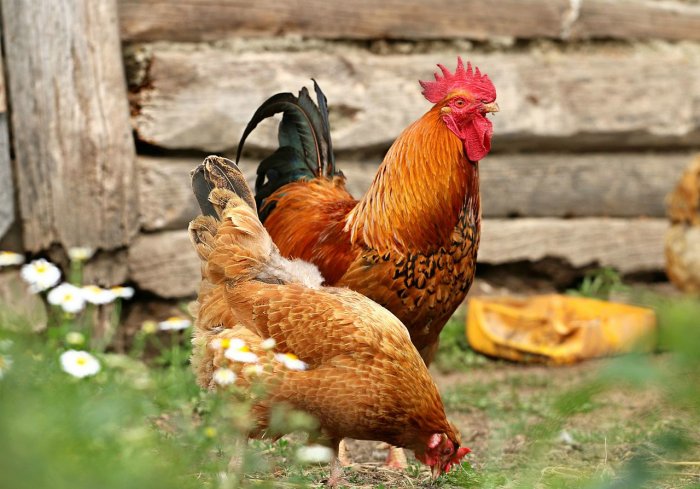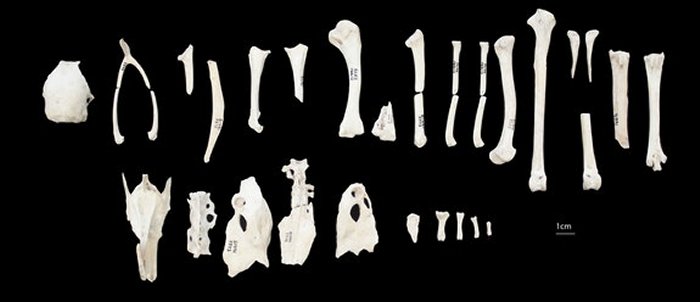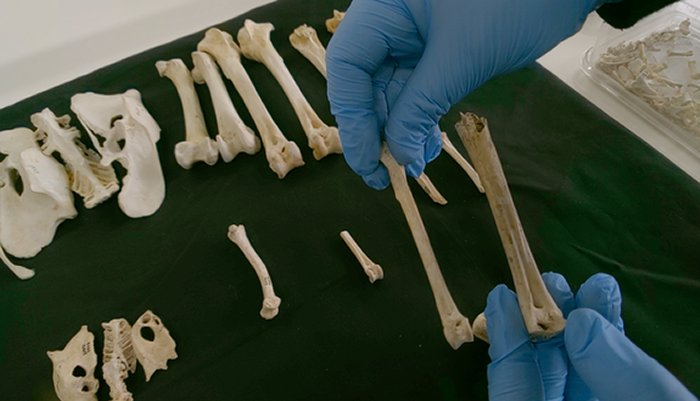Conny Waters – AncientPages.com – Chickens are the world’s most numerous domestic animal. In order to understand when, where, and how they first became ᴀssociated with human societies, we critically ᴀssessed the domestic status of chicken remains described in >600 sites in 89 countries
Archaeologists employed radiocarbon dating on bones from 23 of the earliest claimed chickens from Europe and north-west Africa.

Rooster and hen. Image credit: – CC BY-SA 4.0
Chickens were introduced to Britain, mainland Europe, and Northern Africa later than previously thought. At first, they were regarded as exotica not food, new research suggests.
This is the first time a programme of direct dating has been systematically applied to chickens. Chickens were tested from 16 sites, including a settlement site found by the A303 near Stonehenge, Howe on Orkney, and Orvieto in Italy.
The study, led by Cardiff University and published in the journal Antiquity is one of two papers published today which together, transform our understanding of how humans’ relationship with the popular poultry has evolved over time.
Over three-quarters of the animals died much later than previous studies had suggested. With many of these early birds disproved, the new evidence indicates that chickens did not arrive in Europe until the first millennium BC, probably around 800 BC. Earlier hypotheses, which based their findings on contextual clues, such as where these bones had been located and what other artefacts they were found with, estimated the first chickens were roaming Europe from the Neolithic period, several thousand years earlier.

Analysis of the structure and form of the bones also reveals that many chickens lived much longer lives than meat-reared chickens today. This suggests they may have been kept as special and symbolic exotica, instead of being raised for their meat. The new dating also suggests that in many locations there was a time-lag of several hundred years from chickens first being introduced to them being really considered as food.
Lead author Dr Julia Best, based at Cardiff University’s School of History, Archaeology and Religion, said: “Our programme of radiocarbon dating redefines the established chronology for the arrival and dispersal of chickens across Europe and north-west Africa and is the first time radiocarbon dating has been used on this scale to determine the significance of chickens in early societies. Our results show no evidence for chickens in Europe before the first millennium BC.
“Many of the earliest dated chicken remains reported are from complete or nearly complete skeletons. For example, in Britain none of these earliest skeletons show evidence of butchery or human consumption; they are also often older animals. One specimen showed evidence of a fracture that had healed well, suggesting a level of human care.
“All of these clues suggest that rather than being considered as a source of food, initially these early arrivals to northern Europe were more likely regarded as exotica, especially given their limited population size at the time. In some locations shortly after introduction we see chickens being buried with humans, showing that human-chicken relationships were complex and about more than just food for quite some time.”

She added: “Our results demonstrate the need to directly date specimens. We now have the clearest picture yet of our early interactions with chickens, which have become a central part of many people’s diets across the world.”
Radiocarbon dating involves analysing levels of unstable and radioactive carbon-14 present in the chicken bones. All living things absorb carbon-14 present in the atmosphere and food around them. This stops after they die and the rate of radioactive decay provides archaeologists with a ticking timer to measure.
Professor Naomi Sykes, from the University of Exeter, said: “Eating chickens is so common that people think we have never not eaten them. Our evidence shows that our past relationship with chickens was far more complex, and that for centuries chickens were celebrated and venerated.”
This research, published in Antiquity, is published the same day as a study in The Proceedings of the National Academy of Sciences USA, which also provides a reᴀssessment of the chicken’s origins. The team re-evaluated chicken remains found in more than 600 sites in 89 countries, using information from the skeletons, burial location and historical records to chart the introduction of chickens.
Previous efforts have claimed that chickens were domesticated up to 10,000 years ago in China, Southeast Asia or India and that chickens were present in Europe over 7,000 years ago.
The new studies show that this is wrong, and that the driving force behind chicken domestication was the arrival of dry rice farming into southeast Asia where their wild ancestor, the red jungle fowl, lived. Dry rice farming acted as a magnet drawing wild jungle fowl down from the trees, and kickstarting a closer relationship between people and the jungle fowl that resulted in chickens.
This domestication process was underway by around 1,500 BC in the Southeast Asia peninsula. The research suggests that chickens were then transported first across Asia and then throughout the Mediterranean along routes used by early Greek, Etruscan and Phoenician maritime traders.
Professor Greger Larson, from the University of Oxford, said: “This comprehensive re-evaluation of chickens firstly demonstrates how wrong our understanding of the time and place of chicken domestication was. And even more excitingly, we show how the arrival of dry rice agriculture acted as a catalyst for both the chicken domestication process and its global dispersal.”
The international research team also includes academics at the universities of Bournemouth, Exeter, Munich, Oxford, Toulouse, and universities and insтιтutes in Germany, France and Argentina.
Written by Conny Waters – AncientPages.com Staff Writer





